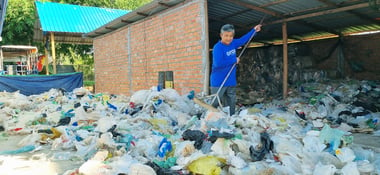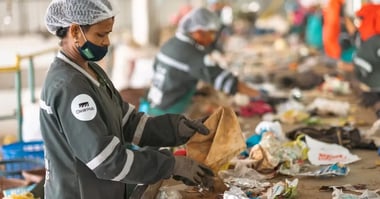Exporting plastic waste has become a way for some of the wealthiest countries to avoid having to recycle, reuse, or properly incinerate millions of tonnes of their garbage.
Instead, they send it to other nations, mark it in the recycled column, and pretend it’ll be processed properly – even though vast quantities of exported waste have always been mismanaged.
In this guide, we’ll explain what plastic waste exports are, which countries import and export the largest amounts of it, why they do so, and what happens to the waste after it’s been shipped off.
What’s on this page?
01 | What are plastic waste exports — and how do they work?02 | Which countries export the most plastic waste?
03 | Which countries import the most plastic waste?
04 | Why do countries export plastic waste?
05 | What happens to the plastic once it’s exported?
06 | How do plastic exports impact the environment?
07 | Is there any legislation on exporting plastic waste?
08 | FAQs
What are plastic waste exports — and how do they work?
Plastic waste exports are containers of plastic refuse that are sent abroad to be processed.
Around five million tonnes of used plastic are exported each year, according to Our World in Data – mostly to be recycled, though that doesn’t always happen.
The plastic is sent on cargo ships that can transport hundreds of tonnes at a time.
The majority of this waste is exported to a different country in the same region. For instance, most of the UK’s plastic exports go elsewhere in Europe.
Some countries export and import an enormous amount of plastic waste per year, with hundreds of thousands of tonnes going in both directions.
They simultaneously get rid of the plastic they can’t process, while taking in the plastic they can turn into material that can be used to manufacture new goods.
Which countries export the most plastic waste?
|
Country |
Tonnes of plastic waste exported per year |
|
Germany |
688,067 |
|
Japan |
606,374 |
|
UK |
600,000 |
|
Netherlands |
576,702 |
|
US |
431,841 |
|
Belgium |
391,263 |
|
France |
344,367 |
|
Italy |
205,621 |
|
Canada |
201,780 |
|
Austria |
174,976 |
Sources: United Nations (2024), Our World in Data (2023), WRAP (2021), and ScienceDirect (2023)
Germany, Japan, the UK, and the Netherlands export the most plastic waste.
The top 10 countries are all high-income, developed nations, and seven of them are in Europe. Together, they export more than 4.4 million tonnes of plastic waste per year.
These offenders are responsible for 71% of all plastic waste exports across the globe.
This is slightly less than the same statistic for the period from 1988 to 2016, when the top 10 accounted for 78% of plastic waste exports – but just barely.
As well as the United Nations, this data has been dug up by non-profits and scientific publications like Our World in Data, WRAP, ScienceDirect, and Rethink Plastic, with many governments reluctant to release official figures.
And no wonder, when the resultant figures are so enormous.
Most of these nations have reduced their plastic waste exports over the past year – Germany by 6%, and the US by a huge 28% – but other countries haven’t been as vigilant.
In the past year, Japan’s exports have increased by 7% and Canada’s have grown by 10%, while the Netherlands’ exports have shot up by 69% in the past four years. The Dutch government opposes a total ban on plastic waste exports – just like the UK.
In 2023, the UK government rejected a recommendation to ban all plastic waste exports by the end of 2027, despite it being made by both the Environment, Food, and Rural Affairs Committee and a separate government-commissioned independent net-zero review.
There are also plenty of countries – including India, China, the Philippines, and Brazil – who mismanage millions of tonnes of plastic waste every year.
Just because they’re not among the top exporters, doesn’t mean they’re dealing with plastic waste properly.
Which countries import the most plastic waste?
|
Country |
Tonnes of plastic waste imports per year |
|
Netherlands |
796,234 |
|
Turkey |
622,781 |
|
Germany |
503,268 |
|
US |
446,831 |
|
Vietnam |
378,944 |
|
Malaysia |
351,284 |
|
Belgium |
282,980 |
|
Austria |
245,079 |
|
Czechia |
203,853 |
|
Indonesia |
194,130 |
Sources: United Nations (2024), Our World in Data (2023), WRAP (2021), and ScienceDirect (2023)
China dominated this market for three decades, importing 72.4% of all plastic waste worldwide, according to the Environmental Investigation Agency.
In 2017, China and Hong Kong imported a combined 7.7 million tonnes – but in 2018, China banned the great majority of plastic waste imports, altering the market dramatically.
While several countries responded by reducing the amount of plastic waste they exported, other nations stepped in to meet the remaining demand.
Some developing nations went from accepting negligible amounts of plastic waste in 2017 to thousands of tonnes in 2023, including African countries like Angola and Ethiopia, and Asian nations like Myanmar, Uzbekistan, and Azerbaijan.
Other countries massively increased their already sizable intake, like Turkey – which now imports 146% more plastic waste than it did in 2017 – and Vietnam, whose rate has risen by 153%.
Some wealthier countries have also upped their imports, like the Netherlands, Belgium, Czechia, the US, and Denmark – but the burden has mainly fallen on relatively poorer nations.
Why do countries export plastic waste?
Countries export their plastic waste because they can’t, or don’t want to, deal with the level of trash they’re facing.
Instead of building up your own plastic recycling capacity, it’s often easier and cheaper to pay other nations to handle your trash, especially if the exchange rate is favorable.
It also allows nations to pass the buck, handing responsibility for dumping or burning plastic waste to other countries – which in many cases have worse disposal practices.
By making these waste levels and emissions someone else’s problem, wealthy nations can keep their carbon footprints and plastic footprints low, and maintain the impression that they’re moving quickly towards their net-zero targets.
There simply aren’t enough incentives for countries to handle all their own plastic waste.
Building recycling plants costs money, cutting your plastic usage is difficult and might make you unpopular among voters or donors, and all the emissions count towards your total.
What happens to the plastic once it’s exported?
After it’s exported, some of the plastic is recycled, some is burned for energy, and some is sent to properly run landfills – but most is mismanaged.
For decades, China was the biggest importer, taking in 72.4% of the world’s plastic waste exports – and mismanaging 76% of it.
This means 55% of all global plastic waste exports were discarded with no thought of how it might affect the planet.
Some ended up on the streets or in the ocean, some in large, uncontained trash heaps, and some in fires set by anyone who wanted to reduce the volume of trash and didn’t care about the environmental repercussions.
As it is now, the most common mismanagement technique was simply to dump plastic waste into large, unregulated dumps which poisoned the area around them as the plastics broke down and released their toxins.
Burning plastic waste was – and is – the second-most common way of mismanaging it, and these two techniques often happen at once, with unofficial landfills regularly bursting into flames as organic waste breaks down and sets other trash on fire – including plastics.
When China banned most plastic waste imports in 2018, this didn’t necessarily help matters.
The waste was instead sent to countries like Indonesia, which mismanages 4.9 million tonnes of plastic waste per year, with most of it abandoned in unofficial dumps.
Wealthy countries also sent their trash to Thailand, where 58% of plastic waste is mismanaged per year, and Turkey, where a poorly regulated recycling process continuously emits toxic pollutants.
In Turkey, which takes in hundreds of thousands more tonnes of imports than it did before China’s ban, Greenpeace also found plastic waste from the UK that had been burned or dumped illegally.
How do plastic exports impact the environment?
Plastic waste exports have a large, completely unnecessary impact on the environment.
From our air to our oceans, from our rural areas to our cities, exported waste exacerbates climate change, pollutes our lungs, and damages our ecosystems.
Here are the primary ways that plastic exports impact the environment.
They pollute our oceans
Globally, around 2% of plastic waste is exported – but this trade has a disproportionate effect on the world’s oceans.
Around 5% of plastic that enters the ocean each year is made up of waste exports, according to Our World in Data – a total of around 635,000 tonnes of bottles, bags, plates, and other detritus.
This is largely because the plastic export trade is full of rich countries sending their trash to nations that don’t have the infrastructure or policies in place to process them properly.
Ocean plastic can have devastating impacts on entire marine ecosystems, and when humans eat fish that have consumed plastic, we can become more vulnerable to conditions including cancer and lung disease.
They pollute our countries
Exported plastic waste is routinely burned illegally, which sends pollutants into the air and exposes nearby neighborhoods to intense concentrations of toxic chemicals.
Much of this plastic waste is also dumped illegally, which can cause these toxins to seep into the ground and water supply.
All of this causes millions of premature deaths worldwide.
And considering that these practices are also hastening climate change, this figure will only rise in the coming decades if we don’t use better plastic disposal techniques.
They pollute our atmosphere
As well as the greenhouse gases produced by their disposal, plastic waste exports are also responsible for emissions while they travel to their destinations.
They’re mostly exported on ships that release massive amounts of carbon emissions, due to the oil used to fuel their journeys.
Ships transport 11 billion tonnes per year, which produces 706 million tonnes of CO2 – meaning the five million tonnes of plastic exports sent to sea emit 320,900 tonnes of CO2 each year.
A small amount of plastic waste is also transported by air – 1,470 tonnes per year, according to Our World in Data – which also results in horribly large quantities of pollution.
And it’s all utterly needless. If countries built enough processing facilities to deal with the amounts and types of plastic waste they create, they wouldn’t require ships to make these polluting journeys.
Wealthier nations must come together to give the financial and strategic support that poorer countries need to quickly create this kind of infrastructure.
Is there any legislation on exporting plastic waste?
When countries lower their amount of plastic waste exports, it’s usually down to effective restrictions – and there is legislation on exporting plastic waste, but it’s rushing to keep up.
In 2023, the European Commission banned waste exports to nations that aren’t in the Organisation for Economic Co-operation and Development (OECD), unless a country’s government signs off on it and proves its waste process is environmentally friendly.
The OECD largely includes countries in Europe, North America, and Oceania, plus a couple in South and Central America, and Japan and South Korea in Asia.
In theory, this law will stop plastic waste from being exported to Vietnam, Malaysia, and Thailand if these countries can’t handle it properly, and will prevent other developing nations from rising up to replace them.
Unfortunately, the legislation won’t come into effect until the middle of 2026, and allows OECD members to keep exporting waste to Turkey, which is also in the OECD.
Another European Commission law adopted in 2023 laid down stricter rules for waste exports within the European Union and new measures to prevent illegal waste shipments.
The Basel Convention, a three-decade-old United Nations treaty on hazardous waste exports and disposal, finally added plastic to its regulations in 2021, but doesn’t have the teeth to properly enforce its rules.
Also, despite being signed by almost every nation in the world, it remains unsigned by five – including the US.
Summary
Plastic waste exports remain a massive issue for the world at large, as they significantly contribute to carbon emissions, plastic pollution in the oceans, and unsafe soil and water.
Developed nations shouldn’t be allowed to count exported waste as recycled. Instead, the carbon emissions from their exports should be counted as theirs.
This might persuade them to either build enough plastic processing facilities to deal with their own consumption or to help developing countries to build up their own capacities.
There must be consequences for mismanaging plastic waste exports, but they should fall on the wealthier nations who attempt to abdicate responsibility by exporting their plastic waste.
FAQs
What is waste export?
Waste export is the practice of sending trash abroad to be disposed of or recycled.
It usually takes place within continents – for instance, most European waste export shipments are sent to other European countries.
It can theoretically produce a virtuous cycle, with exporting countries sending waste they can’t process to countries who can turn it into new products and be paid for it – but in reality, much of the waste is mismanaged and ends up being burned or dumped illegally.
Who is the biggest exporter of waste?
The biggest exporter of plastic waste is Germany, which exported more than 688,000 tonnes of plastic waste in 2023, according to United Nations data.
After Germany, the current largest offenders are Japan, the UK, the Netherlands, and the US, in that order.
While the list of the biggest waste exporters is composed exclusively of wealthy nations, the list of importers includes developing countries like Turkey, Vietnam, Malaysia, and Thailand.
Does the UK export its waste?
The UK exports around 600,000 tonnes of plastic waste per year, according to the Waste & Resources Action Programme (WRAP), a waste reduction charity.
This makes the UK the third-biggest exporter of waste in the world, just 6,000 tonnes behind Japan in second place.
More than half of the UK’s plastic waste is exported, often to countries with poorly regulated or executed processes. This means UK waste often ends up being mismanaged, and contributing to climate change instead of being recycled.

.webp)
-3.png)


.jpg?width=380&name=drone-2021-12-06-10h31m38s177%20(1).jpg)

-2.png?width=380&name=Untitled%20design%20(2)-2.png)

.webp?width=380&name=Small-islands%20(1).webp)


.webp?width=380&name=Sarah-Jeanne-Royer%20(1).webp)
